PRODUCER RESOURCES
10 TIPS TO MAKE YOUR CONTENT GO VIRAL
By Anne Zeiser
Shared content on social media is the fastest growing and perhaps most influential media force today. It broke the story of the Navy SEAL’s raid on Osama bin Laden, advanced marriage equality, reenergized Star Trek-er George Takei’s career, and launched the selfie. It’s truly the global virtual water cooler. And it rarely operates in a vacuum. As the connective tissue to your film or other traditional and digital media, shared content both markets the story and is the story.
So, increasing your content’s shareability is a top goal. Shared content is an inexpensive means of distribution and promotion that spreads the word and assets for your media project. It’s also a ringing endorsement of it. In a world where friends and family’s approval means as much as critics’, audiences are likely to check out the content that others in their tribe deem share-worthy. And, with easy access to social media on second screens and on the go, sharing is more prevalent than ever. When your fans use, love, and tell others about your media project and its content, that’s a smash hit for you.
As a 21st century media maker and media marketer, you’re already halfway there. You offer huge value to your target audiences simply through the deep bench of assets from your content creation and curation. You have an abundance of content through your film or media project and its marketing. You have considerable expertise and insight into the context and relevancy of your story and its associated genres or themes. You have an array of online distribution platforms – from Web sites and social media to blogs and online video. And you have an entrenched understanding of your niche audiences, knowing who they are, where they go, and what motivates them. For that segment of the audience, you can be the hero.
Is there a secret sauce to making a media or entertainment property’s content go viral? No, but these 10 key tips and their entertainment mini-case studies can help you maximize the impact of your content so that your key audiences will participate with it and share it.
Tip #1: Integrate Your Film and Its Marketing Into a Single Narrative
Tweets or shared online video teasers, once seen as marketing tools for a bigger product, are media products unto themselves. Today, in any form, media content can both advance the storyline and market the story. From the beginning, approach your film or media project and marketing from a holistic content creation perspective. Don’t differentiate between story and marketing. Step back and think of yourself as serving a passionate defined, niche audience by creating, curating, and distributing content. So all of your content – whether “owned” (assets you create such as the film and digital platforms), “paid” (ads and product placement), or “earned” (publicity and social engagement) – are installments in an overall audience experience. As such, your film and its poster, teaser trailer, Facebook page, Web site, ads, actors’ tweets, and special events are all part of its overall narrative, which collectively can enchant your audiences.
Anchorman 2 – Ubiquitous Ron Burgundy
Paramount Picture’s campaign for Anchorman 2: The Legend Continues made Ron Burgundy, the 1970s throwback news anchor, ubiquitous. He was in Buick ads extolling the virtues of glove compartments; on Conan remarking how babies have gotten uglier; on a huge billboard near Penn Station with a 3-D moustache; and on KXMB-TV in South Dakota co-anchoring a live newscast. Each sighting delighted social audiences, fueling speculation about where he’d show up next.
Burgundy also posted about real-world events, like the UK royal baby. Paramount created shareable Burgundy-inspired games and original videos tagged with Burgundy’s tagline, #StayClassy. Because of Will Ferrell’s genius at making the character hilarious in any context, Ron Burgundy went viral.

Tip #2: Think Transmedia
By its very definition, an integrated storytelling approach embraces multiple media platforms. Transmedia simply means storytelling across several media platforms, with each element making distinctive contributions to the audience’s understanding of the narrative or story universe. Using many platforms isn’t new. Leonardo da Vinci was a true fifteenth-century polymath – thinking, creating, and expressing across every conceivable platform of his era. Today’s modern transmedia is about creating immersive storyworlds and engaging audience experiences using various media – film, TV, radio, books, publications, games, online, mobile, music, events, live installations, toys, and more. Being transmedia offers huge benefits. It boosts the chances of your audiences intersecting with your media property on some platforms, thereby cutting through the morass of available content. And providing integrated content on several platforms provides deep participatory experiences that translate into your audiences’ active engagement with your content.
Despicable Me 2 – On air, Online, On the Go…and Even In the Air
Despicable Me 2, the animated film sequel about the evil Gru and his little yellow henchmen, premiered in the U.S. in July of 2013. Six months before, the 165 X 55 foot Minion Despicablimp introduced U.S. audiences’ to the film. It crossed the country three times, appearing at key events – its journey trackable via the film’s Web site. And the appeal of the Minions didn’t end in theaters. As part of the sequel’s release, a free mobile Despicable Me role-playing game launched – downloaded more than 100 million times in its first three months.

Several children’s books released and Despicable Me universe-inspired virtual items were available in the catalogue for the massively popular multi-player online game (MMOG), Roblox. Around the sequel’s release, downloads of the original movie, Despicable Me and existing Minion Madness mini-movies on iTunes, Amazon, and Google Play topped the charts. Universal’s Despicable Me 2 sequel grossed more than $360 million in domestic and almost $1 billion in foreign box office sales.
Tip #3: Offer Value
When your content and its context offer value, your audiences are motivated to explore further or take action – click, view, or share. That’s why so many people vote on American Idol’s winner or create parody videos. With enough value-driven exchanges, audiences choose to become part of your project’s community and story as co-creators, co-marketers, and even as characters. To offer value to your audiences, give them something they didn’t have before – information, insight, or perspective. They want timely, ongoing content and information about your project’s storyworld and production universe. This content is an immediate reward. Through your content, keep the story moving and fresh. Add context and social relevancy. Link your narrative to other important or aligned content. Play generously with other content makers and audiences. Exchange ideas, cross-promote, and give credit to others.
PBS’s Idea Channel and Everything But The News – Feed My Curiosity
PBS’s brand is known for delivering value through quality information and content, much of it long-form. To reach new audiences, PBS created YouTube vlogs and Webisodes that have taken off. Every Wednesday Mike Rugnetta posts new videos on the Idea Channel that examine the connections between pop culture, technology, and art. The channel focuses on audiences’ natural curiosity and uncovers the interesting and the quirky.
In addition, PBS Digital Studios’ humorous original documentary-style series, Everything But the News, follows Steve Goldbloom’s “misadventures as he attempts to cover the startup scene in California” for PBS’s NewsHour. Both series harness, yet poke fun at PBS’s serious, smarty-pants roots, and in their ingenious execution have broadened the pubcaster’s info-curious audience. No surprise, they’re shared widely online and have won a slew of awards.

Tip #4: Invite Your Audiences Into the Tent
Nothing honors audiences more than saying, “come play with me.” Usher your audiences into the tent to help you find, tell, and share your story. You’ll learn what makes your audiences who they are, see new creative possibilities for your project, and understand the power of the collective to promote and, ultimately, self correct. But don’t invite them in if you want to maintain control or are thin-skinned. They can cheerlead, promote, and add humor, but also they can complain, criticize, and deface. If you trust them, your fans will take care of the obnoxious or mean-spirited. And, if you do your job right, these audiences will be some of the most valuable and loyal members of your production and marketing team. With your ongoing content, pay attention to what resonates with audiences and develop new content accordingly. Ask open-ended questions. Invite your audiences to create content around your project. Celebrate and share their responses and user-generated content. Overall, create an organic forum that supports an active, ongoing community around your project. When you’re lucky enough for that to happen, allow it to take on a life of its own and simply feed the beast.
Doritos – Make Me a TV Spot
For several years in a row, Doritos has won the creative MVP award for Super Bowl ads with their crowd-sourced TV spots. They’ve given their audiences standing and voice by allowing them to create their featured ads, decide which will appear during the broadcast, and choose the $1 million grand prizewinner.

The good-natured humor of Doritos’ 2013 “Goat 4 Sale” and 2014 “Time Machine” winners received high ranks among all Super Bowl ads as most liked and most memorable. Proof that anyone can have a great idea and that inviting and celebrating audience participation is a clever engagement and branding strategy. Embracing audience participation has translated into a significant boost in awareness and sales for Doritos.
Tip #5: Make Your Fictional Universe Captivating
Characters and storyworlds offer huge opportunities for socialization, especially among comic book-inspired properties, big franchise films, and AAA game sequels. Because young children don’t distinguish between the real world and characters’ storyworlds, characters like M&M’s mascots, Mickey Mouse, Pokémon, Mario, and Clark Kent have populated kids’ entertainment and products for decades. Traditionally, adults were less likely to enter these story universes. Before social media, viral story mythologies for The War of the Worlds and The Blair Witch Project propelled real audiences into fictional storyworlds by making audiences believe they were factual accounts. With today’s sophisticated audiences, such ruses are much less feasible. And, they’re no longer necessary. Now, adults move seamlessly between fiction and reality to enter narrative experiences and engage with storyworlds and characters – from The Hunger Games’ Panem to House of Cards’ Frank Underwood. Blogs, in-character Twitter accounts, vlogs, and story in-universe Web sites can creatively reveal key aspects of your plot, characters, and storyworld.
The Amazing Spider-Man 2 – Read It…Believe It
The Daily Bugle is a fictional New York City tabloid that has been part of the Marvel Universe since 1962 and was featured on film in 2002 in Spider-Man. To provide backstory and teaser content for the Spider-Man storyworld in between Marc Webb’s two acclaimed films, Sony’s team created The Daily Bugle newspaper on Tumblr for The Amazing Spider-Man 2. The micro-blog’s online version of the publication has its own masthead, a named publisher – J. Jonah Jameson – a city editor, and various reporters who write stories and editorials. These revealing stories have been shared extensively across the Internet, exponentially propelling the ongoing storyline and teeing-up future films and other in-universe properties.
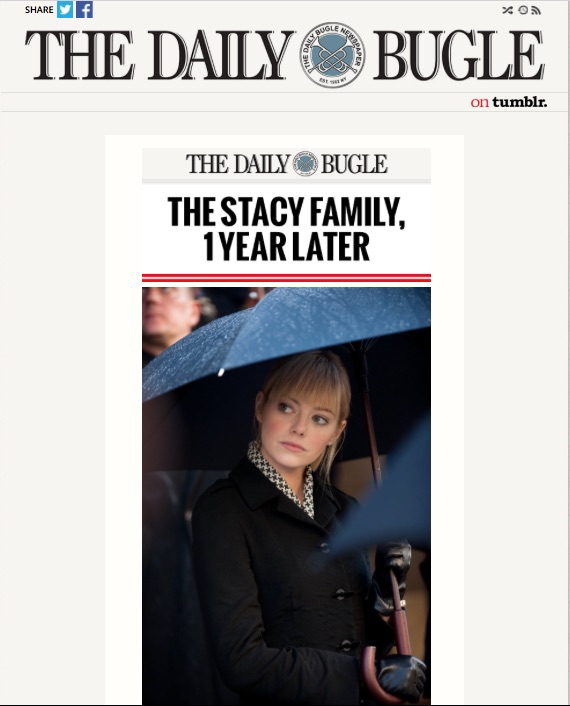
Tip #6: Share Your Production Universe
Today’s audiences are prolific media makers in their own right. They may love and understand your production universe more than you realize. Superfans are voracious consumers of exclusive, behind-the-scenes content. You can socialize your media and entertainment property’s real-world universe by leveraging your artists, fans’ social chatter, promotional assets, and production news. Peter Jackson’s vlog diaries of the production of The Lord of the Rings and The Hobbit include footage of him at work, live fan events with exclusive film footage, Q & As, “how tos” on post-production, and info on Air New Zealand’s tie-in promotions. Jackson’s steady stream of content about the making of the first installment of the trilogy, The Hobbit: An Unexpected Journey generated 800,000 Facebook “Likes” before the film released. Celebrities – including cast, crew, artists, and reality stars – are instrumental in advancing a project’s story and promotion. As a result, conducting social media for a project is often built into celebrities’ contracts, just like press interviews and promotional appearances.
Chef – Cast, Crew, Pets, and Real Chefs
Indie film, Chef used socialized video storytelling to engage fans with its real-world production news and actors. Jon Favreau, the film’s writer, producer, and director (and director of elaborate blockbuster CGI action films, Iron Man and Cowboys and Aliens), embraced Vine videos to connect audiences to his small-scale project. During the casting of the film about restaurant kitchen culture and food, he created and disseminated 6-second micro-videos for new cast members, including Dustin Hoffman and Scarlett Johansson. And, he encouraged the actors to make their own Vines.
Throughout Chef’s production and promotion, Favreau issued celebrity intros, behind-the-scenes clips, promotional tour footage, and even videos of his dogs under the Twitter banner, #chef. This generic hashtag also attracted a broad stream of social audiences interested in food and cooking, adding social content from true foodies. His non-fiction narrative married the social currency of high-profile celebrities with the authenticity of down-home posts from real kitchens – delivering the spirit of the film and its subject to social audiences.

Tip #7: Use Mystery and Reward
Creating intrigue and mystery around a passion topic or project helps it spread. To make content share-worthy, many successful viral entertainment marketing campaigns develop content that first, creates mystery around a passion topic or project; and second, rewards audiences by giving them information or assets that make them feel special or in the know. The powerful tension between these emotions has an amplifying effect. It’s accomplished first by providing teaser content that asks as many questions as it answers to create pent up audience demand; and then by releasing coveted content in a drip-feed to sustain the demand. This places superfans in the position of having content or information first. They share because they know their tribe will be interested and to demonstrate they’re in the know. In turn, audiences in their sphere of influence share it, and so on.
The Dark Knight’s Why So Serious? – Solve the Scavenger Hunt, Meet the Joker
To unite and activate Batman fans in a interactive quest, 42 Entertainment created a participatory alternate reality game (ARG) for Warner Bros.’ The Dark Knight. The 2007 film’s tagline, “Why So Serious?” gave a nod to the film’s protagonist, The Joker, who had not appeared in a Batman film for almost 20 years. Launched 14 months before the film’s release on April Fool’s Day, the “Why So Serious?” experience connected the fiendish character to audiences’ real worlds, engaging them with in-universe and real-world Web sites that fleshed out the fictional Gotham City universe.
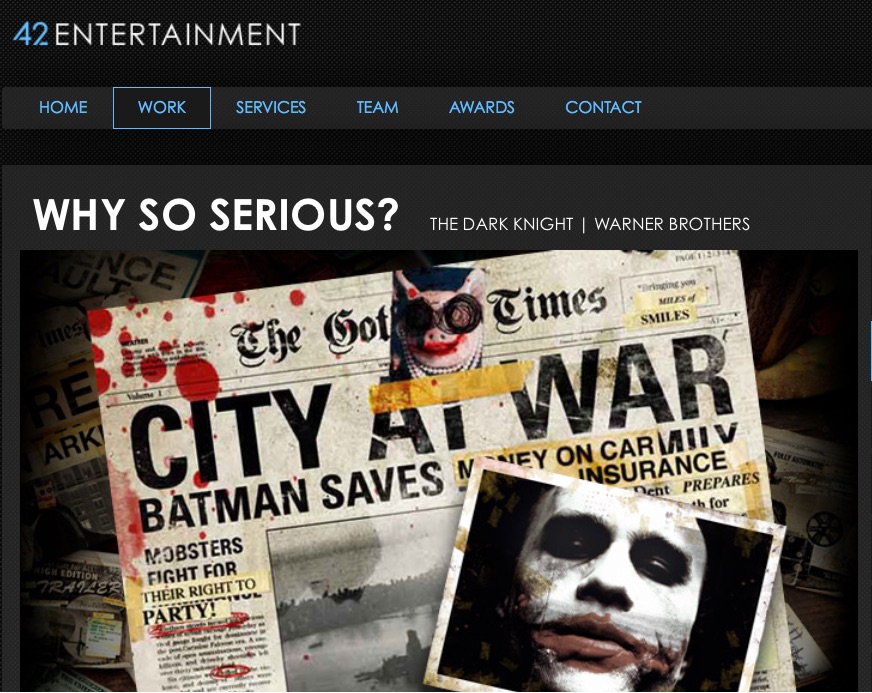
WhySoSerious.com provided audiences with a “to do” list that grew as the film’s release approached, leading them through elaborate scavenger hunts with teaser videos, Web sites, real-world bakeries, and bowling alleys. Superfans who completed these tasks received the ultimate reward of direct communications from The Joker, receiving mobile phones that sent texts about hidden online games and clues. The “Why So Serious?’ multi-month campaign culminated in free tickets to pre-release screenings of the film and engaged more than 10 million unique players in 75 countries.
Tip #8: Make It Fun or Funny
Social media is a fun release for many people. So, to boost your content’s shareability make the experience fun or funny. What’s more fun than puppies and babies? The mere sight of them elicits an emotional reaction, which is why photos and videos of animals and kids are the most shared content on social media. Engaging audiences with fun-loving experiences also increases shareability. At the 2014 Grammys, Arby’s jokingly asked Pharrell Williams for their hat back (his signature hat looks like the Arby’s logo) and social platforms lit up. Humor and comedy are so central to the sensibility of shared content that the Shorty Awards (for social media) has a category just for the funny. Go to any of your social platforms’ newsfeeds and more than half of the content you find is someone’s idea of funny. Whether the original story is comedic or not, in many instances you can make its shareable content fun or funny.
Game of Thrones – #RoastJoffrey – Comedy’s the Flip Side of Tragedy
The Season 3 Game of Thrones episode, “Red Wedding,” which killed off some of the show’s most beloved characters in a bloodbath, was HBO’s most social show in its history. To capitalize on the vehement conversation about despised character, King Joffrey Baratheon, 360i’s off-season campaign leading into the Season 4 premiere mixed the emotion of hate for the young king with the socially-viral technique of comedy. HBO launched an irreverent social media roast of the program’s reviled ruler on Twitter, Instagram, Vine, and Facebook using the hashtag #RoastJoffrey.
Fans, “citizens” such as Arya Stark and Hodor, stars such as Maisie Williams and Kristian Nairn, and even real-world brands spewed their venom. Game of Thrones’ Twitter account hosted the roast, the hashtag tagged the roast content, and the Web site, RoastJoffrey.com, curated the content. The campaign garnered more than 40,000 tweets, including @Charmin’s, “There are some people so crappy even we won’t go near them. #RoastJoffrey #tweetfromthethrone.” Even rival network program @NBCHannibal chimed in, “#RoastJoffrey? Sounds delicious.” The roast became a cultural touchstone.
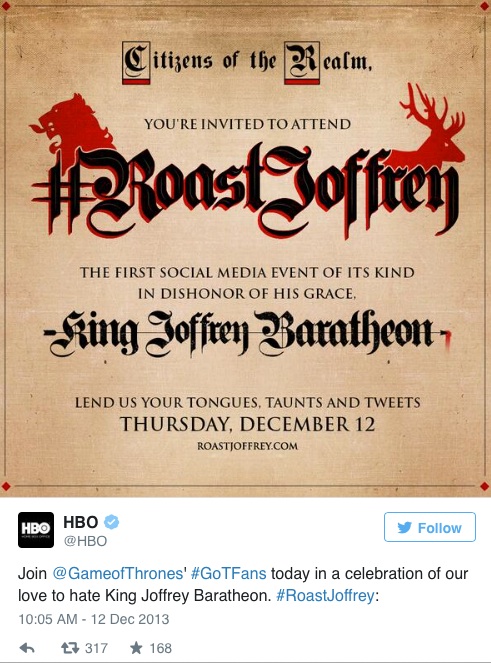
Tip #9: Be Visual
“A picture is worth a thousand words” speaks to the idea that a single image can convey a complex idea. Visuals are consummate storytelling devices. Not only do they communicate concepts and emotions, but they stimulate memory and retrieval of that complex idea when re-seen. Concept art remains seminal to films’ identities. Who can forget the ominous, massive shark lurking beneath the water’s surface ready to attack an unsuspecting swimmer from the 1975 Jaws poster? Or, Saul Bass’s arresting two-minute sequence for the 1960 Hitchcock film, Psycho, using kinetic typography and minimalistic use of color and graphic expression to portend the horrors of things to come. Key art is equally critical to videogames because it portrays the overall story universe, the key characters, and a sense of the all-important gameplay. Because human brains are visually wired for survival, art and video are the most-shared content on social media. Use your concept art, poster, logos, color palette, typography, one-sheet, collateral, title sequence, teaser videos, trailers, and sizzle reels to visually tell, and ultimately, share your story.
Halo 4 – Piece Together the Picture
“Fanboys” and “fangirls” of beloved properties and storyworlds are so interested in the minutiae of a project that product news or promotional assets offer viral opportunities. Two days before the official box art reveal for Halo 4, Xbox used the art as a shareable social vehicle to keep fans feeling like insiders. They sliced the box art up into 32 pieces and seeded each piece across 32 popular social fan communities, challenging fans to cooperate and solve the puzzle together. Within a half-hour, the mind-hive audience had solved the puzzle; within an hour, Halo 4’s box art and the social puzzle was the top story on Kotaku and was then picked up by numerous game, entertainment, and news sites. Social conversation tracking registered a 92 percent positive sentiment. Fans loved piecing together the art to “see” the next iteration of the popular game.
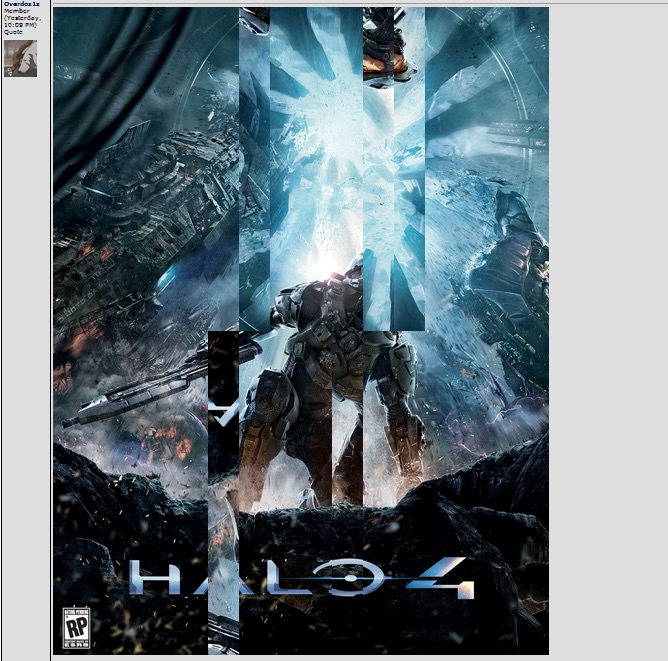
Tip #10: Provide Calls to Action
In order to get things, you must ask for them. If your goal is to get a click, a share, a download, a signed petition, or a butt in a seat at your film, you must point your audiences to it. And, it must be one click away. Audiences will do that next thing when their sense of agency – that they can and should act – is activated. When audiences directly engage with your project and they receive emotional and tangible rewards through more content, they’re inspired to further engage in deeper actions. Your film or project’s content should offer various calls to action on a sliding scale of investment – ranging from simply clicking on a link up to hosting a fundraising event. Therefore, there’s a place for everyone in your project no matter his or her level of engagement or willingness to act. Over time, audiences will ratchet up their engagement to do more and become your most ardent ambassadors. These calls to action can be about delivering story or sharing content, or they can be about changing the world.
Food, Inc. – Healthier Eating, One Bite at a Time
Participant Media’s Oscar-nominated and Emmy award-winning documentary, Food, Inc. by filmmaker Robert Kenner was a startling exposé of the USDA and FDA-regulated U.S. industrial food production system that churns out unhealthy food, often in unsafe conditions. Variety said the film “does for the supermarket what Jaws did for the beach.”
But shock and fear wasn’t enough. There was an opportunity to change audiences’ attitudes and behaviors using the film and the calls to action in TakePart’s awareness campaign and the film’s subsequent FixFood social media and video campaign. Research conducted by USC’s Lear Center showed that emotionally-engaged Food, Inc. audiences encouraged their friends, family, and colleagues to learn more about food safety; shop at local farmers markets; eat healthier food; and consistently buy organic or sustainable food.
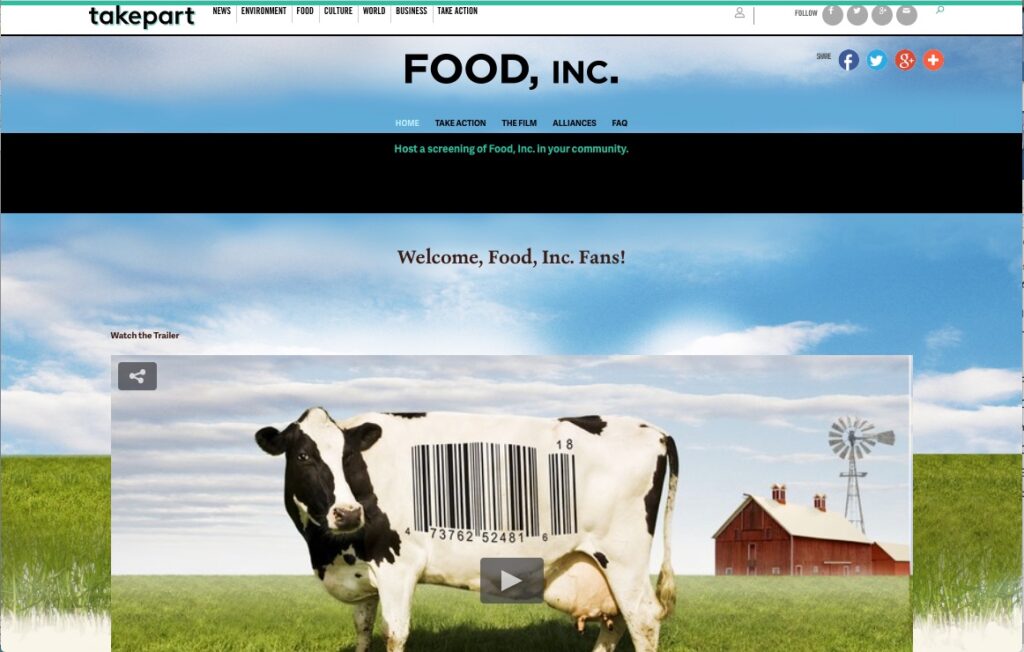
Epilogue
Honoring your audiences – listening to what they say, following them where they go, determining what they want, and inviting them to play in the sandbox – is the single most important aspect of making your content go viral. If you want audiences to share a video, retweet a Twitter message, or follow a clue, it must be worthwhile. That’s why you must know your audiences well, because what’s worthwhile to one person is a total waste of time for someone else. Then you’ve rewarded them, whether by unlocking hard-earned exclusive content or delivering a feeling of satisfaction for helping a good cause.
Your shareable content can be the voice of a fictional character, the forum for audience contribution to the plot, the big reveal of the project’s poster, or the launching pad for project news. By using all of your project’s assets, you can create a global, real-time conversation among your project’s follower base of passionates, influencers, evangelists, and content co-creators. These coveted ambassadors can help you explore, embellish, and spread your story.
About the Author
 Anne Zeiser is a critically-acclaimed transmedia and social impact producer who has stewarded series and films for PBS, produced news for CBS, managed national brands for marketing firms, and founded Azure Media, which develops transmedia projects on air, online, and on the go. Anne is also the author of Transmedia Marketing: From Film and TV to Games and Digital Media. Connect with Anne on the book’s companion Web site, on Twitter, and on Facebook.
Anne Zeiser is a critically-acclaimed transmedia and social impact producer who has stewarded series and films for PBS, produced news for CBS, managed national brands for marketing firms, and founded Azure Media, which develops transmedia projects on air, online, and on the go. Anne is also the author of Transmedia Marketing: From Film and TV to Games and Digital Media. Connect with Anne on the book’s companion Web site, on Twitter, and on Facebook. Explore more articles and research at Producers Resources.